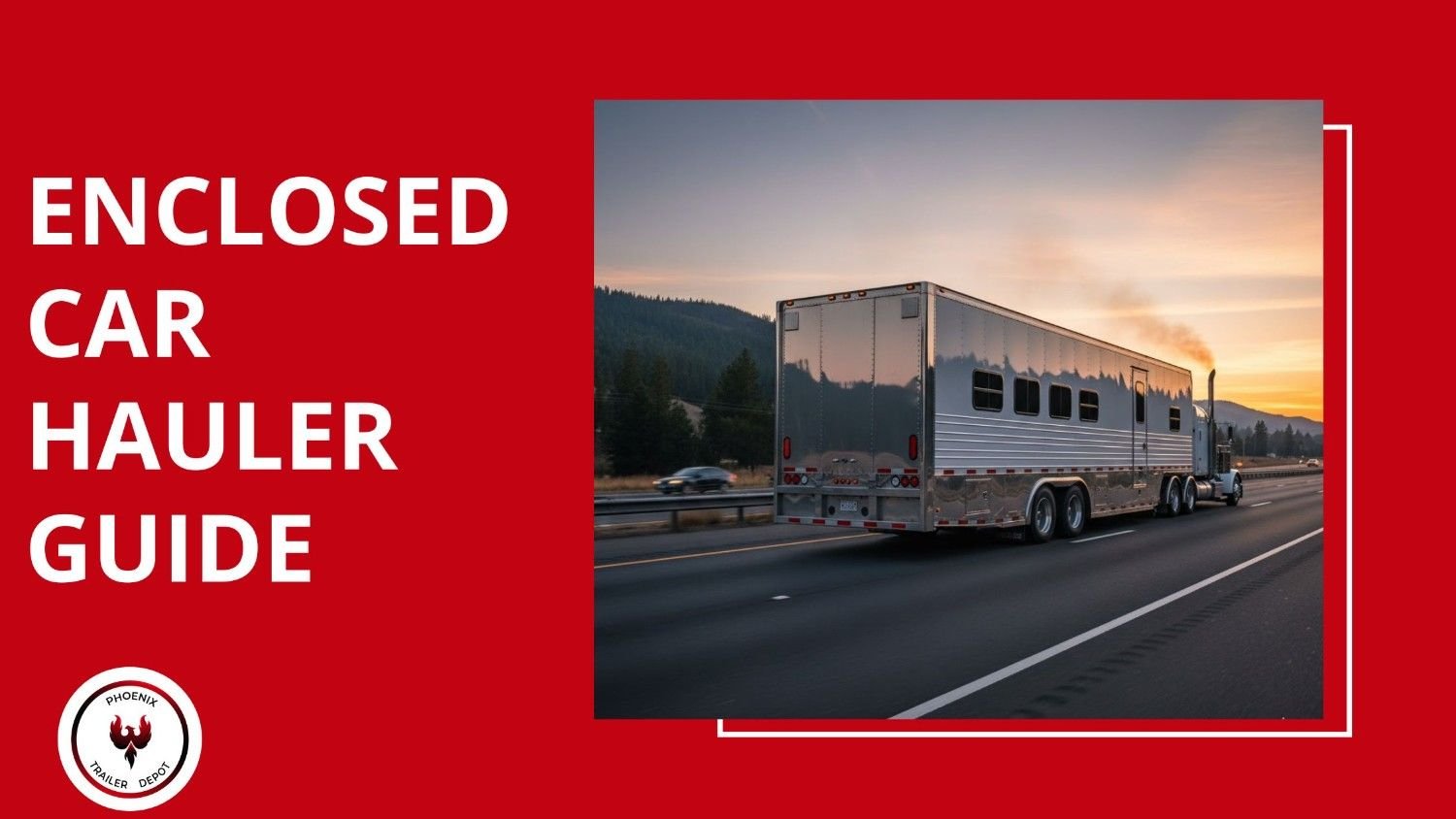I still remember the first time I saw a car glide out of one of those Enclosed Car Hauler; the kind most people overlook until they see one in action. The vehicle rolled down the ramp effortlessly, its paint gleaming as if it had never touched the road. I couldn’t help but wonder: how does a car travel hundreds of miles, through weather and traffic, and still look flawless? That’s the magic of an enclosed car hauler. It’s not just a trailer; it’s a moving sanctuary designed to protect what’s inside.
Anyone who’s ever transported a car knows there’s a world of difference between open and enclosed hauling. Open trailers expose your car to rain, wind, dust, and flying debris. Enclosed trailers, on the other hand, shield your vehicle completely, ensuring it arrives in pristine condition.
This guide dives deep into everything you need to know about enclosed car hauler — from their types and benefits to buying tips, towing advice, and maintenance insights. By the end, you’ll feel like you’ve loaded your own car inside one and taken it for a smooth, secure ride.
What makes an Enclosed Car Hauler Special?
At first glance, it’s just a box on wheels. But step closer, and it’s obvious: it’s engineered to keep vehicles safe, clean, and secure. Unlike open trailers, enclosed car hauler fully protect cars from weather, road debris, and even prying eyes.
The best part? They’re surprisingly versatile. Whether it’s a single weekend trip with one car, moving a collection across the state, or transporting multiple cars for a show, the trailer adapts. Inside, there’s room for ramps, tie-downs, and even extra gear if you need it. Some trailers even have lighting and small storage areas so you can prep or check vehicles without fumbling in the dark.
It’s hard to overstate how much peace of mind comes with this kind of trailer. You can focus on the drive, the route, or the event ahead – not on whether a passing truck might chip your paint.
The Real Benefits of Using Enclosed Car Haulers
People choose enclosed car haulers for many reasons, but the most obvious is protection.
1. Weatherproof Security
Rain, snow, sun, and wind – all the things that slowly wear down a vehicle – don’t touch your car when it’s inside a solid enclosure. Even small road debris, like rocks or sand kicked up by trucks, can damage paint or trim on an open trailer. Inside an enclosed trailer, your car doesn’t just arrive intact – it arrives flawless.
2. Theft and Tampering Prevention
Anyone who’s parked their car overnight at a rest stop knows the anxiety. A locked, enclosed trailer removes that stress. No one can peek inside, let alone try to steal or tamper with your vehicle.
3. Flexibility in Use
From a single sports car to a collection of classics, these trailers are built to adapt. Some are single-car setups for easy towing; others are multi-car monsters with hydraulic lifts or ramps for stacking. You can even carry motorcycles or tools, depending on the design.
4. Professional Look and Feel
For businesses, car shows, or transport services, an enclosed trailer is a statement. It says you care about the vehicles, your clients, and the journey. That professional image can be just as valuable as the protection it provides.
5. Reduced Insurance Risk
Some insurers recognize that a vehicle traveling in an enclosed hauler is far less likely to be damaged or stolen. That can mean lower premiums – especially for classic, high-end, or exotic cars.
Types of Enclosed Car Haulers
Not all enclosed car haulers are the same. Understanding the types can make the difference between a perfect fit and a frustrating purchase.
1. Single-Car Trailers
- Length: Typically 12–16 feet
- Perfect For: One car, short trips, or weekend events
- Pros: Lightweight, easy to tow, relatively affordable
- Cons: Limited space – only one car
2. Multi-Car Trailers
- Length: 20–40 feet, sometimes longer
- Perfect For: Dealers, collectors, car shows, or auctions
- Pros: Can carry multiple vehicles, more storage for gear
- Cons: Heavier, requires a stronger tow vehicle
3. Trailers with Lift Systems
- Use Case: Stack or lift cars for maximum efficiency
- Pros: Ideal for dealers or race teams needing multiple cars in one trip
- Cons: Requires extra care and maintenance
4. Low-Profile Trailers
- Design: Extra-low floors for race cars or vehicles with low clearance
- Pros: Avoids scraping on ramps or floors
- Cons: Specialized; not ideal for taller vehicles
5. Trailers with Optional Living or Workspace
Some trailers include a small space to rest, prep, or work on vehicles during long trips or events. These are ideal for long-distance travel or multi-day shows.
Must-Have Features in Enclosed Car Haulers
Buying the right enclosed car hauler isn’t just about size – the details matter.
1. Ramp or Door Type
- Rear ramps are most common. Some split ramps or foldable designs handle heavier or multiple vehicles.
- Side doors provide quick access for inspections or small gear without opening the whole rear.
2. Tie-Down Systems
- E-track rails, D-rings, or wheel chocks keep the car in place.
- Proper tie-downs prevent shifting, scratches, or stress on suspension during transport.
3. Flooring Options
- Aluminum diamond plate: lightweight, durable, and easy to clean
- Plywood with anti-slip mats: practical and cost-effective
- Steel: extremely strong, but heavier and prone to rust
4. Interior Clearance
Make sure there’s enough height for standing inside if needed and width for larger vehicles.
5. Axle and Suspension
- Single axle: easy to tow and maneuver, ideal for one vehicle
- Tandem axle: better weight distribution, smoother ride for long trips
- Independent suspension: reduces road vibration stress on high-value cars
6. Ventilation and Lighting
- Small vents reduce condensation and prevent mold
- LED lights make it easier to inspect cars at night or in dim areas
Everyday Uses for Enclosed Car Haulers
Enclosed car haulers aren’t just for long hauls; they’re versatile in daily life.
- Dealer Transport: Moving vehicles between lots or from auction houses
- Car Shows: Ensures cars arrive in pristine condition, ready to display
- Race Teams: Safely transport race cars, gear, and even tires
- Classic Car Moves: Seasonal moves, auctions, or private sales
- Personal Moves: Cross-state moves without worrying about weather or road damage
Cost Considerations
Trailer prices vary depending on size, features, and materials. Here’s a general idea:
| Type | Price Range |
| Single-Car (12–16 ft) | $7,000 – $15,000 |
| Multi-Car (20–30 ft) | $15,000 – $40,000 |
| Large Multi-Car / Specialty | $40,000 – $100,000+ |
Extras like lifts, hydraulic ramps, lighting, or insulation can add $5,000–$15,000 but are often worth the investment.
Towing Tips and Safety
Even the best enclosed car haulers is useless if it’s not towed correctly.
- Match the trailer’s weight to your vehicle’s towing capacity
- Use proper hitching, weight distribution, and brake controllers
- Secure cars properly with tie-downs
- Inspect tires, brakes, lights, and ramps before each trip
- Practice turns, backing up, and stops in safe areas
Step-by-Step Guide to Loading and Unloading
One of the most stressful parts of hauling a car is getting it on and off the trailer safely. The good news? Once you understand the steps, it becomes routine.
1. Prepare the Trailer
Before anything, inspect the trailer:
- Check that ramps are secure and free of debris.
- Ensure tie-down points are clear and functional.
- Confirm brakes, tires, and lights are in working order.
2. Plan Your Path
Know how you’ll drive the car onto the trailer. Ensure there’s enough space on both ends, and that the angle of the ramp isn’t too steep – low-profile cars can scrape if not approached carefully.
3. Use Spotters if Possible
Having someone guide you can save scratches, bumps, or misalignment. Even one person watching mirrors and wheel placement can make a huge difference.
4. Secure the Vehicle
Once the car is on the trailer:
- Engage the parking brake.
- Use tie-downs on all four wheels if possible.
- Check that straps are tight but not cutting into tires or suspension.
5. Double-Check Before Driving
Take a final look around the trailer. Make sure nothing is loose, straps are tight, and ramps are clear. A minute of checking now can save thousands in potential repairs later.
Maintenance Tips for Longevity
A well-maintained car haulers protects your car and prevents headaches. Here’s a checklist:
Exterior Care
- Wash after each trip, especially if you’ve been on salty or muddy roads.
- Inspect for scratches, dents, or corrosion – small issues can escalate quickly.
- Wax painted areas if your trailer has custom finishes.
Tires and Suspension
- Check tire pressure before every trip.
- Rotate tires periodically to prevent uneven wear.
- Inspect suspension components for wear or rust.
Ramp and Door Maintenance
- Lubricate hinges, rollers, and locks regularly
- Inspect ramps for cracks, loose bolts, or wear.
- Ensure hydraulic systems (if any) are functioning smoothly.
Interior and Ventilation
- Keep floors clean to prevent slips or debris damage.
- Ventilate after trips to avoid mold or condensation.
- Check lighting and electrical connections periodically.
Smart Upgrades and Accessories
Once you’ve been hauling cars for a while, you’ll notice small things that make a huge difference. Here are some worth considering:
1. LED Lighting
Bright, energy-efficient interior lights make loading, unloading, and inspections easier, especially at shows or nighttime transport.
2. Tool and Accessory Storage
Small cabinets or wall racks for straps, tire chocks, or cleaning supplies keep the trailer organized.
3. Spare Tire Mount
Flat tires happen unexpectedly. A mounted spare keeps you ready for the road.
4. Roof Vents or Fans
If you’re transporting cars in warm climates or closed spaces for long periods, ventilation reduces heat buildup and condensation.
5. Hydraulic or Electric Lifts
For multi-car trailers, lifts save time and protect vehicles from scraping during stacking.
6. Interior Insulation or Climate Control
Especially useful for luxury, classic, or sensitive vehicles – keeps temperatures stable and prevents condensation.
Choosing the Right Trailer Size
Selecting the correct size can be tricky. A trailer that’s too small risks damage; too large can be difficult to tow and inefficient.
1. Single-Car Trailers
Perfect for individual vehicles or weekend trips. Easy to tow, park, and maneuver. Ideal for sports cars, classics, or personal vehicles.
2. Multi-Car Trailers
Best for dealerships, collectors, or transport businesses. Can carry multiple vehicles, saving trips, but requires careful towing planning.
3. Longer or Custom Trailers
If you plan to transport unusual vehicles (low clearance, oversized, or exotic), consider custom layouts with ramps, tie-downs, and proper spacing.
Insurance and Liability
Transporting cars isn’t risk-free. Having proper insurance is essential.
- Check with your auto insurance about coverage during transit.
- Many insurers recommend or require trailers with enclosed protection.
- Consider adding a trailer insurance policy for extra coverage.
Insurance often covers theft, collision, or damage, but policies vary – always read the fine print.
Comparison: Open vs. Enclosed Car Haulers
Sometimes people wonder if an open trailer might suffice. Here’s a quick breakdown:
| Feature | Open Trailer | Enclosed Trailer |
| Weather Protection | None | Full protection from rain, snow, sun |
| Security | Minimal | Lockable, solid walls prevent theft |
| Vehicle Exposure | Dust, debris, stones | Vehicles remain pristine |
| Flexibility | Often lighter, cheaper | Versatile, protects high-value cars |
| Cost | $1,000–$5,000 | $7,000–$100,000+ depending on size/features |
The choice is simple if you care about your car’s condition, value, and safety: enclosed wins every time.
Real-World Uses
Enclosed car haulers aren’t just for collectors – they serve many people in daily life.
- Classic Car Transport: Seasonal moves, auctions, shows
- Dealership Deliveries: Vehicles from auctions, storage, or other lots
- Race Teams: Transport cars, motorcycles, or equipment securely
- Business Fleet Moves: Small transport or logistics companies
- Personal Cross-State Moves: Keep a car safe when relocating
Even if you only transport occasionally, the trailer becomes a versatile tool for peace of mind.
Cost Breakdown and Budgeting
Understanding cost helps you plan realistically. Here’s a guide:
| Trailer Type | Price Range (USD) |
| Single-Car 12–16 ft | $7,000 – $15,000 |
| Multi-Car 20–30 ft | $15,000 – $40,000 |
| Specialty / Large Multi-Car | $40,000 – $100,000+ |
Extras:
- Hydraulic lift systems: $5,000–$10,000
- Climate control or insulation: $2,000–$8,000
- Interior lighting and storage: $500–$2,000
- Branding, wraps, or custom paint: $1,000–$5,000
Budget carefully: a cheaper trailer may save upfront but cost more in repairs or vehicle damage over time.
Final Thoughts
Enclosed car haulers aren’t just trailers – they’re an investment in peace of mind. They protect your vehicles, provide security, and give you confidence on the road. Whether you’re transporting one car across town or a fleet across states, they make every mile safer and every arrival smoother.
The key is to choose wisely: the right size, proper tie-down systems, good axles, and maintenance. With those in place, an enclosed car hauler becomes more than a trailer – it becomes a trusted partner for your vehicles.
FAQs
1. How do I know what size trailer I need?
Consider the type and number of vehicles you’ll transport, plus extra room for ramps and tie-downs. Slightly larger is safer than just barely fitting.
2. Are enclosed trailers difficult to tow?
They’re heavier than open trailers, but with proper hitching, weight distribution, and towing practices, they’re manageable even for first-time users.
3. Can I transport low-clearance cars safely?
Yes, but choose low-profile trailers or ramps designed to prevent scraping. Hydraulic lift systems also help.
4. How often should I inspect my trailer?
Before every trip: check tires, brakes, lights, and tie-downs. Monthly: inspect ramps, flooring, suspension, and ventilation.
5. Are enclosed trailers worth the investment for occasional use?
Even if used occasionally, they protect vehicles, prevent costly damage, and offer peace of mind – often paying for themselves in avoided repairs or paint work.
6. Can I customize the interior?
Absolutely. Many owners add E-track rails, LED lighting, cabinets, and even climate control. Customization improves safety and convenience.
7. How do I maintain the tie-down systems?
Check straps, hooks, and rails for wear. Lubricate moving parts, and replace anything showing signs of fatigue to prevent vehicle movement.
8. Do I need a special license to tow?
In most states, standard licenses are sufficient for trailers under a certain weight. Always check local regulations for your trailer’s gross vehicle weight rating (GVWR).





Leave a Reply